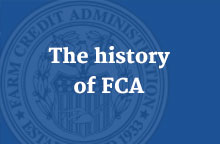Risk-based capital stress test
FCA requires Farmer Mac to conduct a risk-based capital stress test. This test determines the minimum amount of capital that Farmer Mac is required by FCA regulation to hold.
The minimum requirement is designed to ensure that Farmer Mac would have enough capital to withstand a 10-year period characterized by stressful credit, interest rate, and operational conditions. (The regulations regarding this test are located at 12 CFR part 652, subpart B.)
How the test works
When running the stress test, Farmer Mac must use loan default rates and loan losses that are similar to the rates and losses that occurred during the most stressful two-year period for agricultural mortgages in the past. The loan losses also must be similar to those experienced in contiguous areas of the United States containing at least 5 percent of the total U.S. population.
The risk-based capital stress test consists of two Excel spreadsheets that incorporate loan portfolio data and other data reflecting Farmer Mac’s current condition and operations.
The first Excel spreadsheet, called the Credit Loss Module 4.2, applies statistical loan loss equations to Farmer Mac’s loan portfolio data to produce the estimated credit losses for a 10-year stress period. It allows Farmer Mac to estimate its credit risk.
The second spreadsheet, the RBCST 4.2, takes the credit loss results from the Credit Loss Module and adds interest rate stress information and other Farmer Mac data. With this spreadsheet, Farmer Mac can produce estimated financial statements for the 10-year stress period. The spreadsheet calculates the estimated equity and reserves necessary for Farmer Mac to maintain positive capital over the 10 years.
Then, as required by the Farm Credit Act, the result produced by the RBCST 4.2 is multiplied by 1.3 to account for management and operations risk. The total represents the minimum capital Farmer Mac is required to hold as of the date the test is run.
The RBCST was updated from 4.1 to 4.2 effective July 23, 2018. For information about the differences between recent versions of the application, see About RBCST revisions. Note: Although Credit Loss Module 4.1 did not change at all, we changed its version number to 4.2 to keep it consistent with the RBCST.
How the test applies to Farmer Mac’s rural utility loans
In addition, the Farm Credit Act requires FCA to use the test to estimate the credit risk on rural utility loans in Farmer Mac’s portfolio. We must use a rate of default and loan loss that reflects the risks in rural electric and telephone facility loans. We are also required to incorporate an interest rate risk stress scenario.
How you can use the test
Individuals with financial modeling experience can use the two spreadsheets, along with publicly available Farmer Mac data, to run the test and derive approximately the same risk-based capital results that Farmer Mac and FCA derive.
Because not all Farmer Mac data are publicly available, you will have to make several assumptions and will not be able to reproduce exact results. These spreadsheets should be used with the guidance provided in the Farmer Mac risk-based capital regulation and technical appendix.



